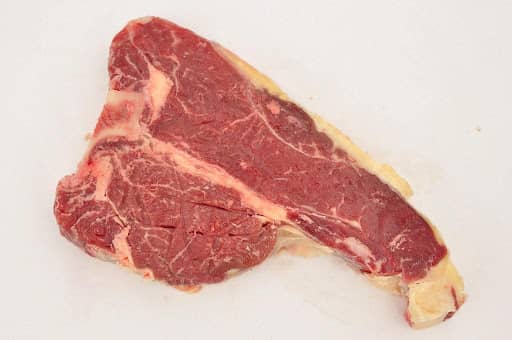
A hefty cut of porterhouse steak on your plate is enough to make your mouth start watering immediately. Like most beef, it’s rich in protein, has no carbs, and can be part of a balanced diet. But, digging into detailed porterhouse nutritional facts is a good idea if you’re deciding how much of it to include in your meal plans.
Here’s what you need to know about this delectable cut from the short loin that’s a steakhouse favorite, mostly because of its enticing flavor and massive size.
Porterhouse Nutritional Facts
A typical suggested serving of steak is about three ounces. However, a typical porterhouse steak is a whopping 24 ounces, often making it a good meal for at least two people to split. The USDA breaks down porterhouse steak nutrition by 100-gram servings, which is about the equivalent of 3.5 ounces. Here’s a glimpse of what you can expect to get out of each serving:
- Calories: 139
- Total Fat: 5.3 g
- Saturated Fat: 2 g
- Cholesterol: 57 mg
- Sodium: 43 mg
- Potassium: 266 mg
- Carbohydrates: 0 g
- Protein: 22.7 g
- Zinc: 2.53 mg
Continue reading to learn how porterhouse stacks up to other types of steak when it comes to eating a balanced, mindful diet.
The Good
Want to add porterhouse steak to your menu? Here are some of the good features it has going for it.
High Protein, Low Carb
If you’re following a high-protein, low-carb diet or simply want to watch the number of carbohydrates you eat daily, then steak could be a good option. Like other cuts of beef, porterhouse packs in protein, offering close to 23 grams in a 3.5-ounce serving. Considering that you’ll probably eat at least double that if you have a porterhouse on your plate, you could end up with most of the protein your body needs for the day and zero carbs.
However, you’ll want to be careful about the amount of protein you’ll get if you do have a large portion of porterhouse that steakhouses are known to serve. Eating too much protein each day could worsen problems with your kidneys and may lead to dehydration, nausea, and cardiovascular issues. Talk to your doctor to make sure you aren’t overdoing your protein intake.
Rich in Nutrients and Vitamins
Porterhouse steak is full of nutrients and vitamins that are essential to your body. Let’s look at a few of them:
- Vitamin B12: B12 helps the body form DNA and red blood cells. Research also shows that it could reduce the risk of cardiovascular and cognitive conditions.
- Vitamin B6: This vitamin helps the body efficiently break down protein, carbs, and fats. It also could play a role in preventing diseases like cancer and cardiovascular conditions.
- Iron: The body needs iron to grow properly and move oxygen to the lungs and muscles. It also is necessary for blood cell production.
- Zinc: Zinc boosts the immune system to allow the body to heal wounds and injuries, prevent and fight diseases, and allow cells to grow.
- Selenium: Selenium is also a powerful nutrient for the immune system. It can reduce the inflammatory response to let the immune system be more efficient at doing its job.
- Niacin: Niacin is also known as vitamin B3. It can lower bad cholesterol and raise good cholesterol to better regular cholesterol levels in the body.
- Riboflavin: The body needs riboflavin for several processes, including supporting brain function and protecting the digestive tract.
The Not-So-Good
At a glance, porterhouse seems to be right in line with many other cuts of steak. And for a small serving, it is. It’s high in protein, has a low number of calories, and is relatively low in fat. The problem with porterhouse steak is that you’ll probably never get a 3.5-ounce serving at a steakhouse or from the butcher shop unless you specifically ask for one.
Porterhouse steaks are huge, and that’s one of the features steak enthusiasts find so appealing about it. However, when you eat a piece that big, you’re easily doubling, tripling, or even quadrupling the amount of everything, like fat and calories. This is one of those cuts that you’ll need to be extra mindful of not to overeat (although we understand the temptation!).
Rather than take on this monster cut of beef by yourself, consider splitting it with someone else or eating some of it and boxing up the rest to take home for tomorrow’s lunch. That way, you’ll benefit from the good parts of porterhouse steak nutrition without overdoing it.
Conclusion: Porterhouse Nutritional Facts
There’s no denying that porterhouse steak is one of the best-tasting steaks that your money can buy. As far as nutrition goes, it can also be an excellent addition to a balanced diet — if you’re careful about portion sizes.
Chicago Steak Company offers USDA Prime and Premium Angus porterhouse steaks in different sizes — from 16-48 ounces — so that you can order the right size for you. Our porterhouse steaks come flash-frozen and individually wrapped to ship in our signature boxes right to your door.

